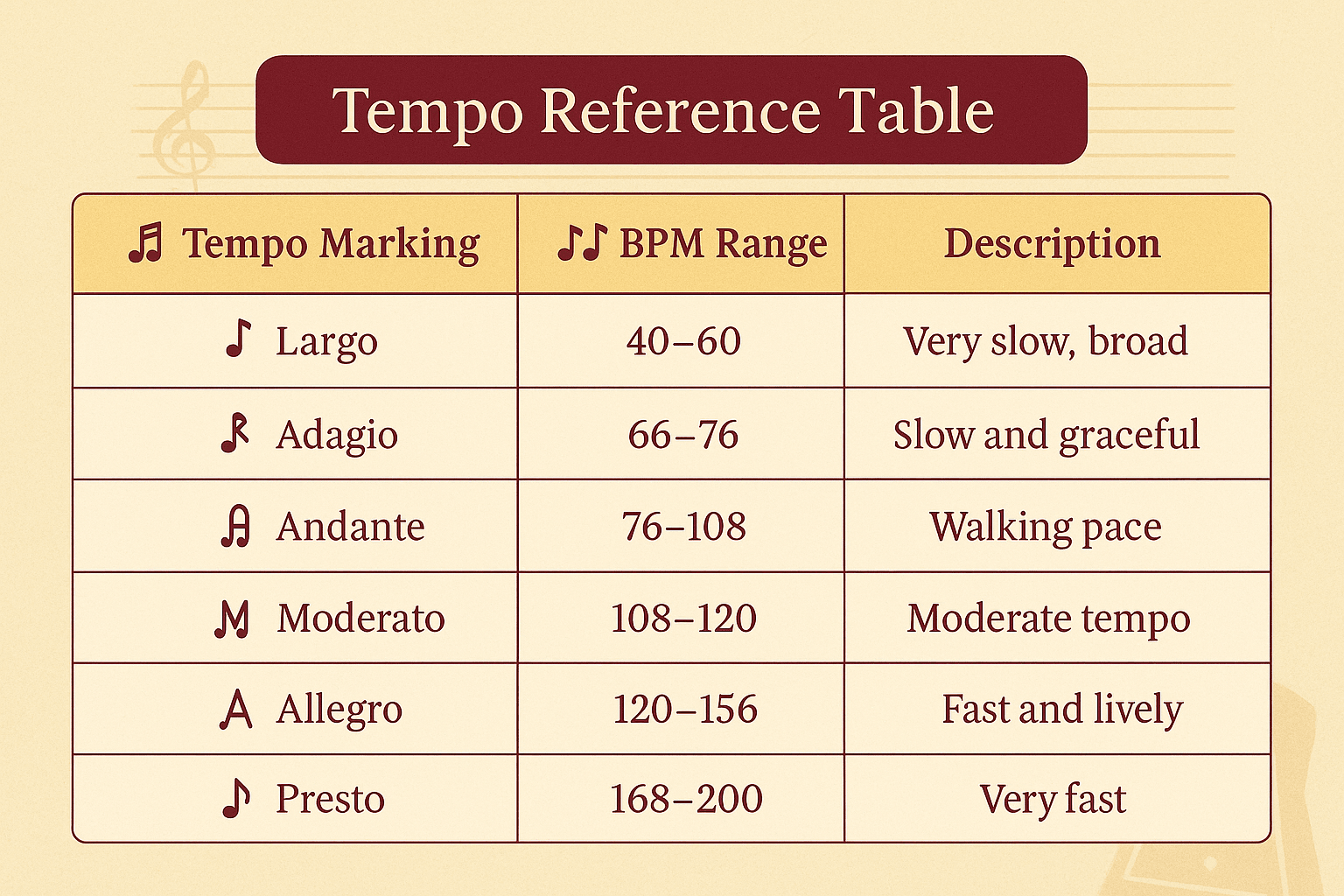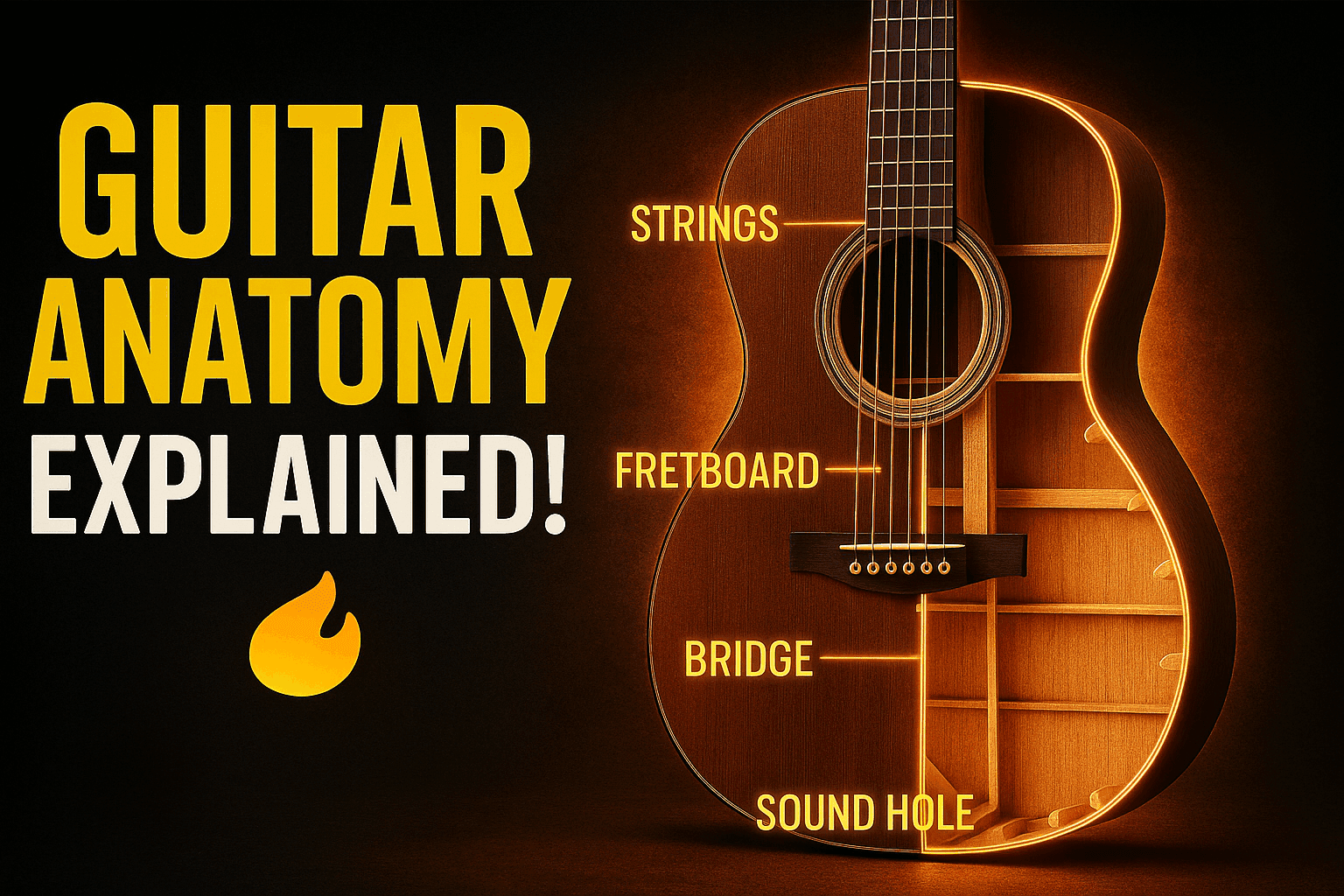
Art Gharana — 10 Mins read
Guitar Anatomy: Complete Guide to Different Parts of a Guitar
Musical Instruments
 Every musician, from beginners to professionals, knows the struggle of keeping perfect timing. The metronome has long been the silent partner that helps them master rhythm and tempo control. Whether you play the piano, guitar, drums, or classical instruments, learning how to use a metronome effectively can transform your entire musical journey. Let’s explore how this small yet powerful device shapes the way music is learned, practiced, and performed.
Every musician, from beginners to professionals, knows the struggle of keeping perfect timing. The metronome has long been the silent partner that helps them master rhythm and tempo control. Whether you play the piano, guitar, drums, or classical instruments, learning how to use a metronome effectively can transform your entire musical journey. Let’s explore how this small yet powerful device shapes the way music is learned, practiced, and performed.
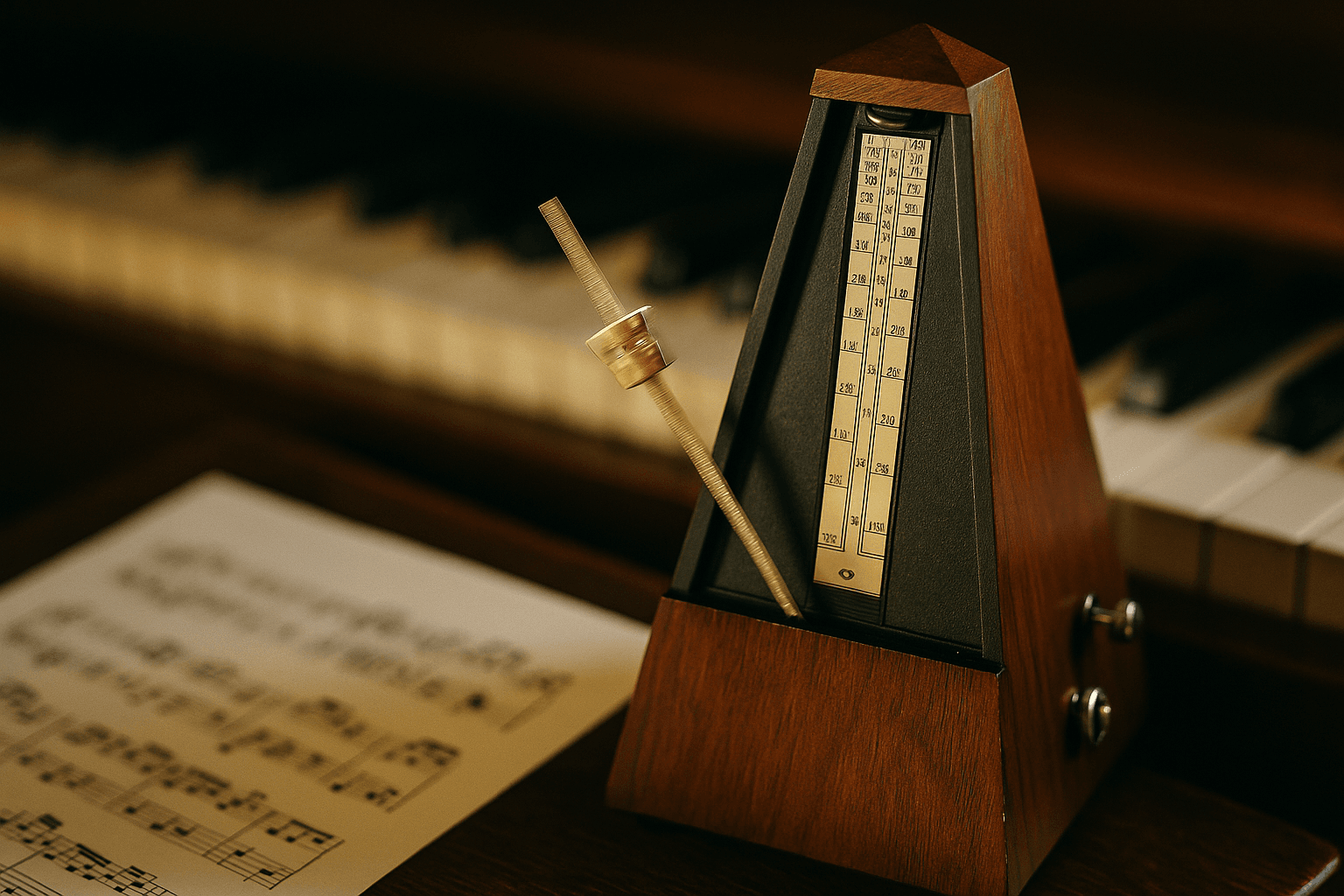 A metronome is more than a ticking clock; it’s a teacher of discipline and timing. In music practice, it trains your internal sense of rhythm, develops timing precision, and improves coordination. Musicians in the USA and around the world use metronomes daily to refine their timing in music practice and build rhythmic discipline. The steady click or beat acts like a mirror reflecting how accurate your rhythm is. Over time, regular practice with a metronome helps you achieve tempo consistency and musical precision that separates amateurs from professionals.
A metronome is more than a ticking clock; it’s a teacher of discipline and timing. In music practice, it trains your internal sense of rhythm, develops timing precision, and improves coordination. Musicians in the USA and around the world use metronomes daily to refine their timing in music practice and build rhythmic discipline. The steady click or beat acts like a mirror reflecting how accurate your rhythm is. Over time, regular practice with a metronome helps you achieve tempo consistency and musical precision that separates amateurs from professionals.
When you begin to train with a metronome, you’ll notice that every note starts to align more smoothly. This habit of keeping to the beat forms the foundation of improving timing and coordination across all instruments. Whether you are in online music classes with metronome or learning music instruments online, you’ll quickly see how the metronome keeps your rhythm stable and focused.
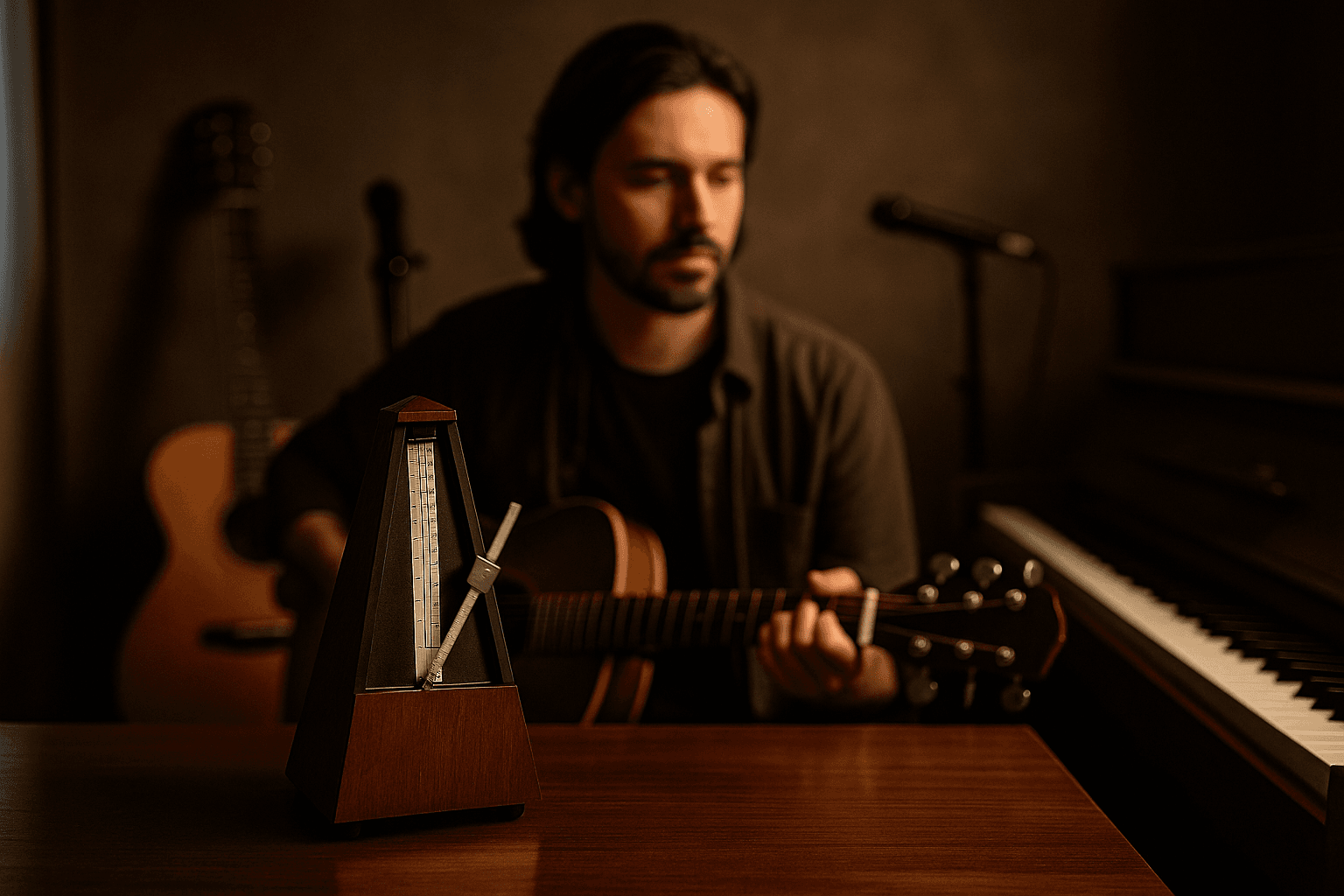 A metronome is a device that produces a consistent beat, usually measured in beats per minute (BPM). Each beat helps a musician maintain an even tempo throughout a piece of music. The invention of the modern metronome is often credited to Johann Maelzel (inventor), though early prototypes existed before him. By the early 1800s, composers such as Beethoven began using metronome markings in their compositions to indicate precise tempos for performers.
A metronome is a device that produces a consistent beat, usually measured in beats per minute (BPM). Each beat helps a musician maintain an even tempo throughout a piece of music. The invention of the modern metronome is often credited to Johann Maelzel (inventor), though early prototypes existed before him. By the early 1800s, composers such as Beethoven began using metronome markings in their compositions to indicate precise tempos for performers.
The beat per minute meaning defines how many beats occur in one minute. For example, 60 BPM means one beat per second, while 120 BPM doubles that speed. In modern music education, metronomes are essential tools that aid rhythm training and performance synchronization. From pendulum metronomes to smartphone metronomes, each version serves the same purpose—to help musicians master timing and control over tempo.
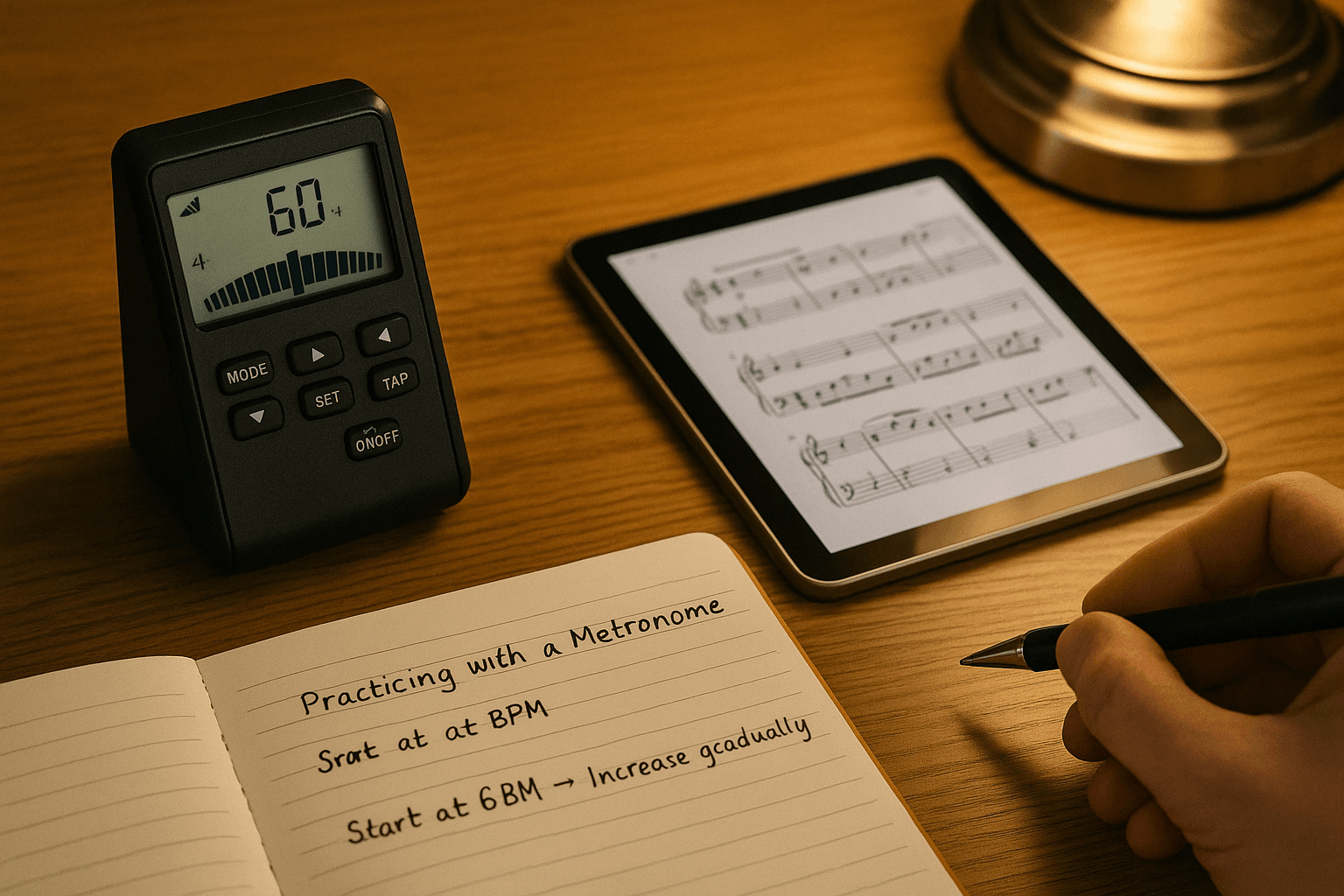 The primary function of a metronome is to help musicians stay on tempo and improve musical timing accuracy. It ensures that you play every note in the right place, creating a consistent rhythmic structure. Another important function is to aid rhythm exercises for musicians. For example, a drummer can use a click track for recording, while a pianist can use a metronome to stabilize tempo in complex sections.
The primary function of a metronome is to help musicians stay on tempo and improve musical timing accuracy. It ensures that you play every note in the right place, creating a consistent rhythmic structure. Another important function is to aid rhythm exercises for musicians. For example, a drummer can use a click track for recording, while a pianist can use a metronome to stabilize tempo in complex sections.
In music education, metronomes help teachers explain tempo markings in music and counting beats per measure more easily. When students use a metronome during practice, it strengthens their internal pulse and develops awareness of rhythm subdivisions. This habit eventually improves performance synchronization when playing in ensembles or orchestras.
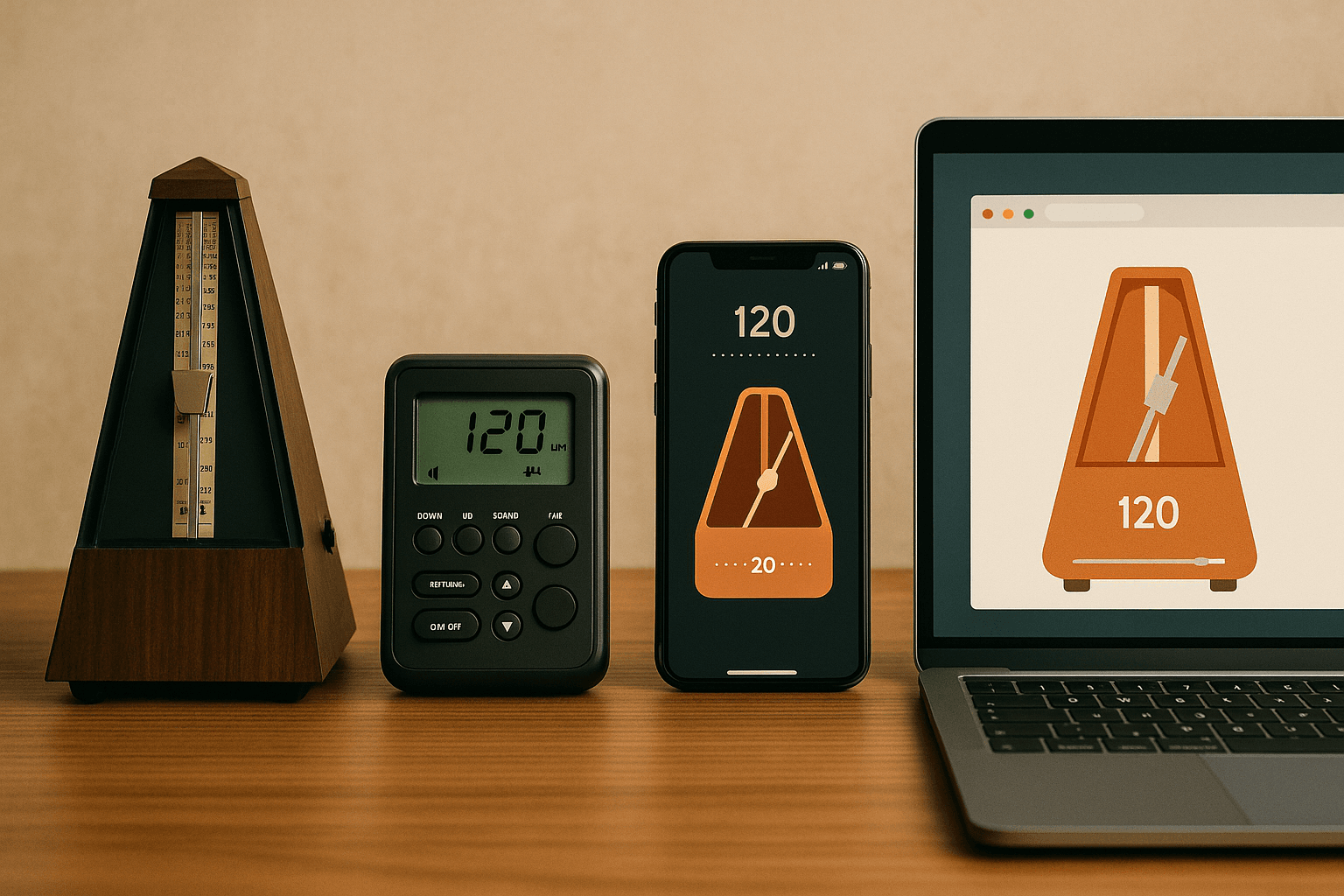 Mechanical Metronomes
Mechanical Metronomes
A mechanical metronome, also called a pendulum metronome, uses a swinging weight to produce a clicking sound at adjustable speeds. It doesn’t require batteries or electricity. Many musicians love its natural movement, which helps visualize tempo. While it may not be as precise as digital versions, it provides a tactile experience that promotes focus and rhythmic discipline.
A digital metronome, sometimes called an electronic metronome, runs on batteries and provides precise tempo accuracy. These devices often include features like adjustable accent beats, rhythmic subdivisions, and tone changes. Musicians who need advanced metronome settings guide prefer them for flexibility. They are commonly used by drummers and guitarists for complex rhythm exercises.
With the rise of smartphones, metronome apps for Android/iOS have become extremely popular. These apps offer features like visual metronome aids, tap tempo options, and preset tempo markings. They allow students in online lessons or online classes to practice anywhere. Apps like Soundbrenner or Tempo Advance even provide vibration feedback for silent practice sessions.
An online metronome tool is ideal for quick access without needing a physical device. These tools often include digital sliders for adjusting beats per minute and time signatures. They are perfect for online music classes with metronome integration and are widely used in digital music learning environments.
 Using a metronome in music is straightforward but requires patience and awareness. You start by selecting a tempo that matches your current playing speed, usually slower than performance tempo. The goal is to align each note or beat with the metronome’s sound. Over time, you can gradually increase the tempo as you become more confident and accurate.
Using a metronome in music is straightforward but requires patience and awareness. You start by selecting a tempo that matches your current playing speed, usually slower than performance tempo. The goal is to align each note or beat with the metronome’s sound. Over time, you can gradually increase the tempo as you become more confident and accurate.
Different instruments use the metronome differently. In a metronome for piano practice, players use it to keep their hands synchronized, especially in fast passages. A metronome for guitar players helps them maintain strumming consistency. Drummers' metronome practice focuses on subdividing beats evenly, while sitar practice tempo and metronome for Indian classical music help maintain complex rhythmic cycles like tala. These diverse applications show how universal the metronome’s role is across musical traditions.
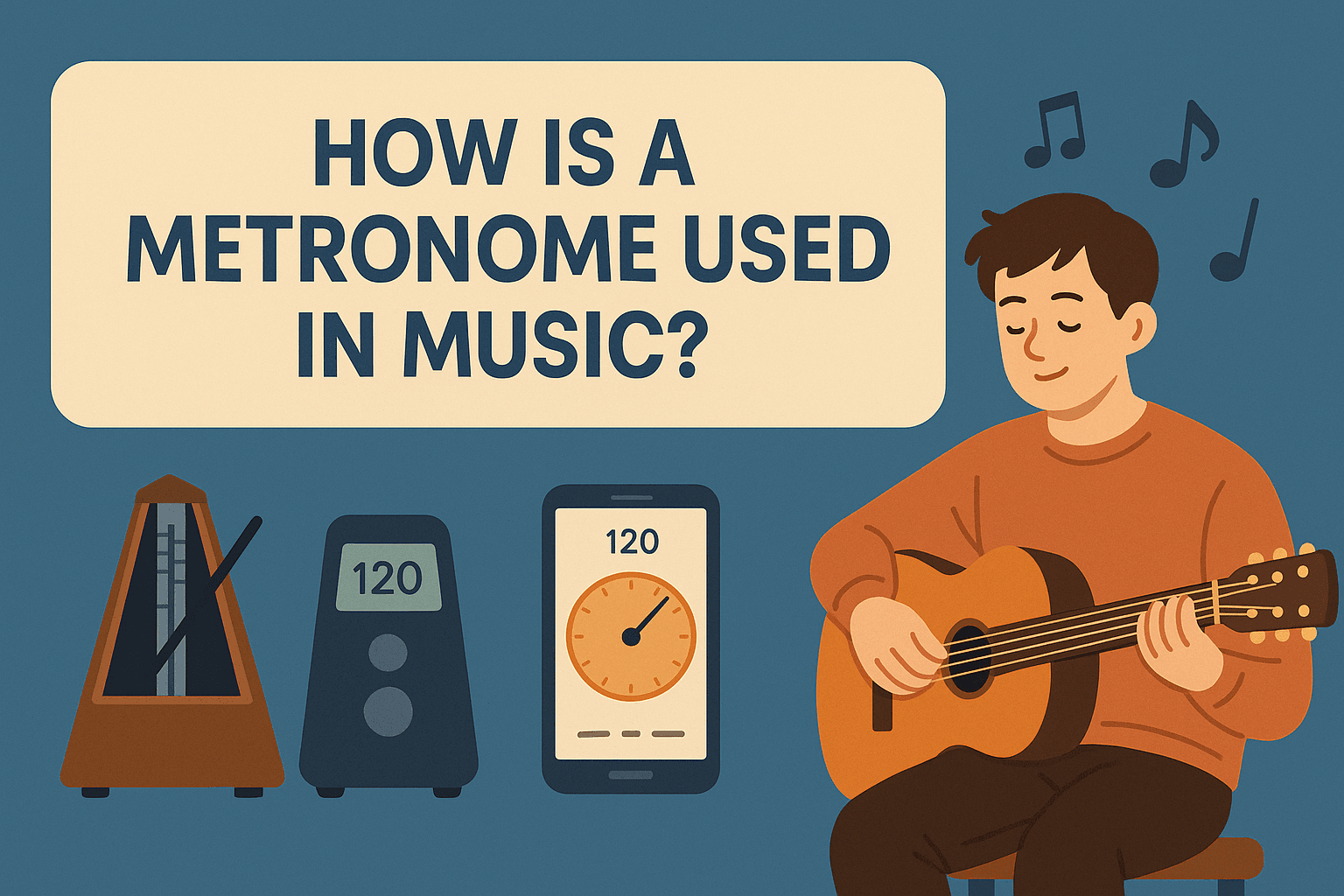
Start by finding the correct beats per minute (BPM) for your piece. Beginners might start slow, around 60–80 BPM. As you progress, adjust the tempo markings gradually until you reach the intended speed. This method ensures steady improvement without losing control.
Every song follows a time signature in music, which defines how many beats fit into one measure. The most common is 4/4, but there are others like 3/4 or 6/8. Set your metronome accordingly so it matches the rhythmic structure of the song.
Slow practice techniques are the foundation of good musicianship. When you play slowly, your brain and muscles learn movements correctly. This prevents errors from becoming habits and improves timing precision over time.
Practicing rhythmic subdivisions like eighth or sixteenth notes enhances your sense of internal rhythm. This habit strengthens musical timing accuracy and helps you understand counting beats per measure more deeply.
Some digital metronomes allow you to mute certain beats. This silent gap technique forces you to rely on your internal pulse, developing stronger rhythmic discipline and confidence in your tempo control.
Once accuracy is consistent, increase the tempo slowly. This step teaches you tempo consistency and prepares you for performance synchronization. Always aim to raise tempo in small increments to avoid mistakes.
Some modern devices and metronome apps offer visual metronome aids or LED flashes instead of sound. These are helpful when practicing in noisy environments or when sound-based clicks are distracting.
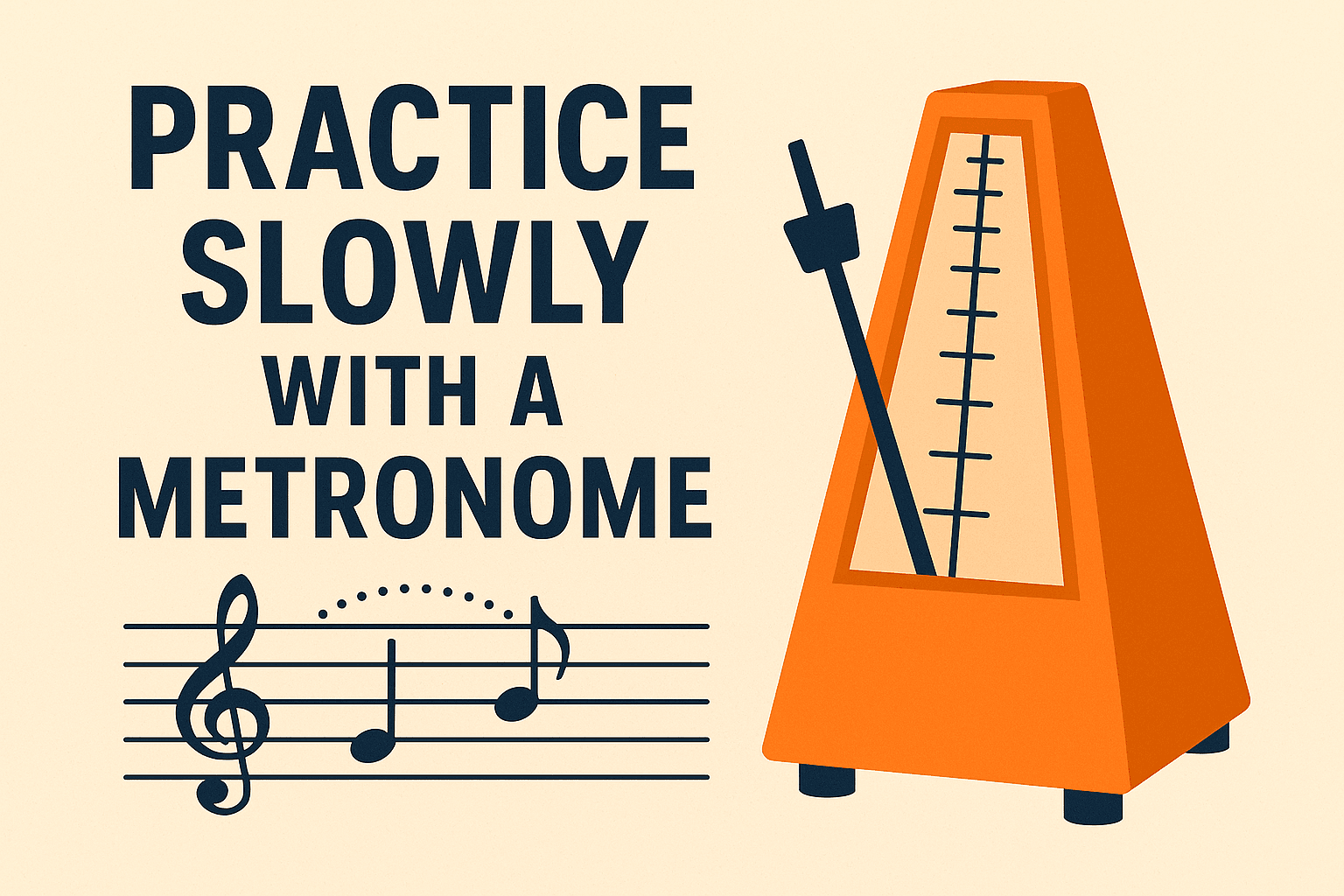
Practicing slowly with a metronome allows you to internalize every beat and note. This builds a strong internal sense of rhythm and helps avoid rushing or dragging in performances.
Slow practice reveals mistakes you might otherwise miss. You become aware of finger placement, breathing, or bow movement, which enhances overall musical precision.
When you practice repeatedly at a controlled speed, your muscles memorize movements correctly. This ensures accuracy even when you later play at full tempo.
Good timing is essential for ensemble coordination. Practicing with a metronome helps you align perfectly with other musicians during performances.
A metronome doesn’t limit creativity; it refines it. Once timing becomes natural, you can add more emotion and musical expression confidently without losing tempo accuracy.
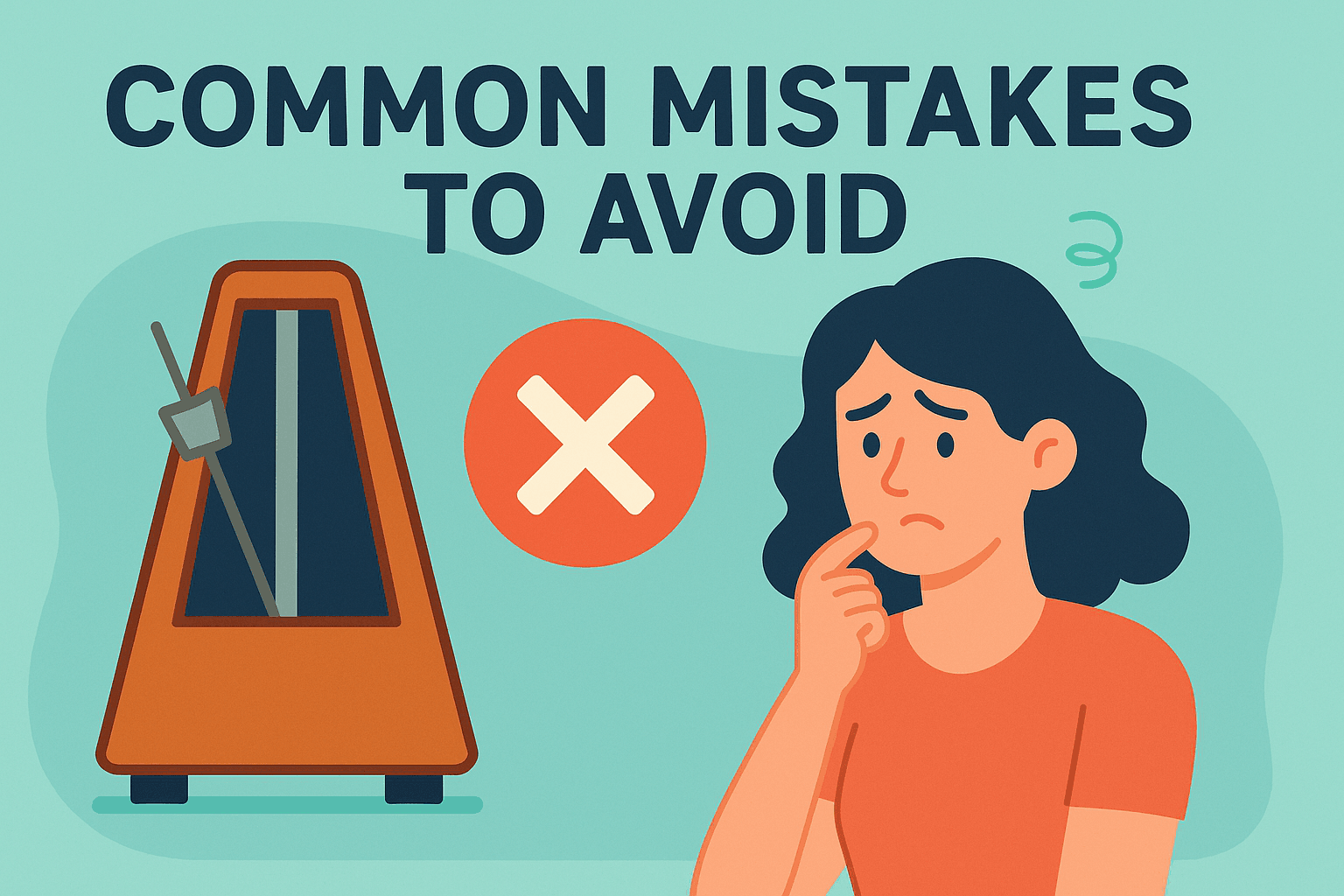 One common mistake is starting at a speed that’s too fast. This leads to sloppy execution and poor rhythm control. Always begin slow and focus on clarity before increasing speed. Another mistake is depending entirely on the metronome. Remember, it’s a tool, not a crutch. The goal is to strengthen your internal pulse, not rely on external sound forever. Many beginners also forget to set the correct time signature, leading to confusion in counting beats. Finally, avoid ignoring rhythmic subdivisions; they are crucial for developing rhythm skills and improving timing and coordination.
One common mistake is starting at a speed that’s too fast. This leads to sloppy execution and poor rhythm control. Always begin slow and focus on clarity before increasing speed. Another mistake is depending entirely on the metronome. Remember, it’s a tool, not a crutch. The goal is to strengthen your internal pulse, not rely on external sound forever. Many beginners also forget to set the correct time signature, leading to confusion in counting beats. Finally, avoid ignoring rhythmic subdivisions; they are crucial for developing rhythm skills and improving timing and coordination.
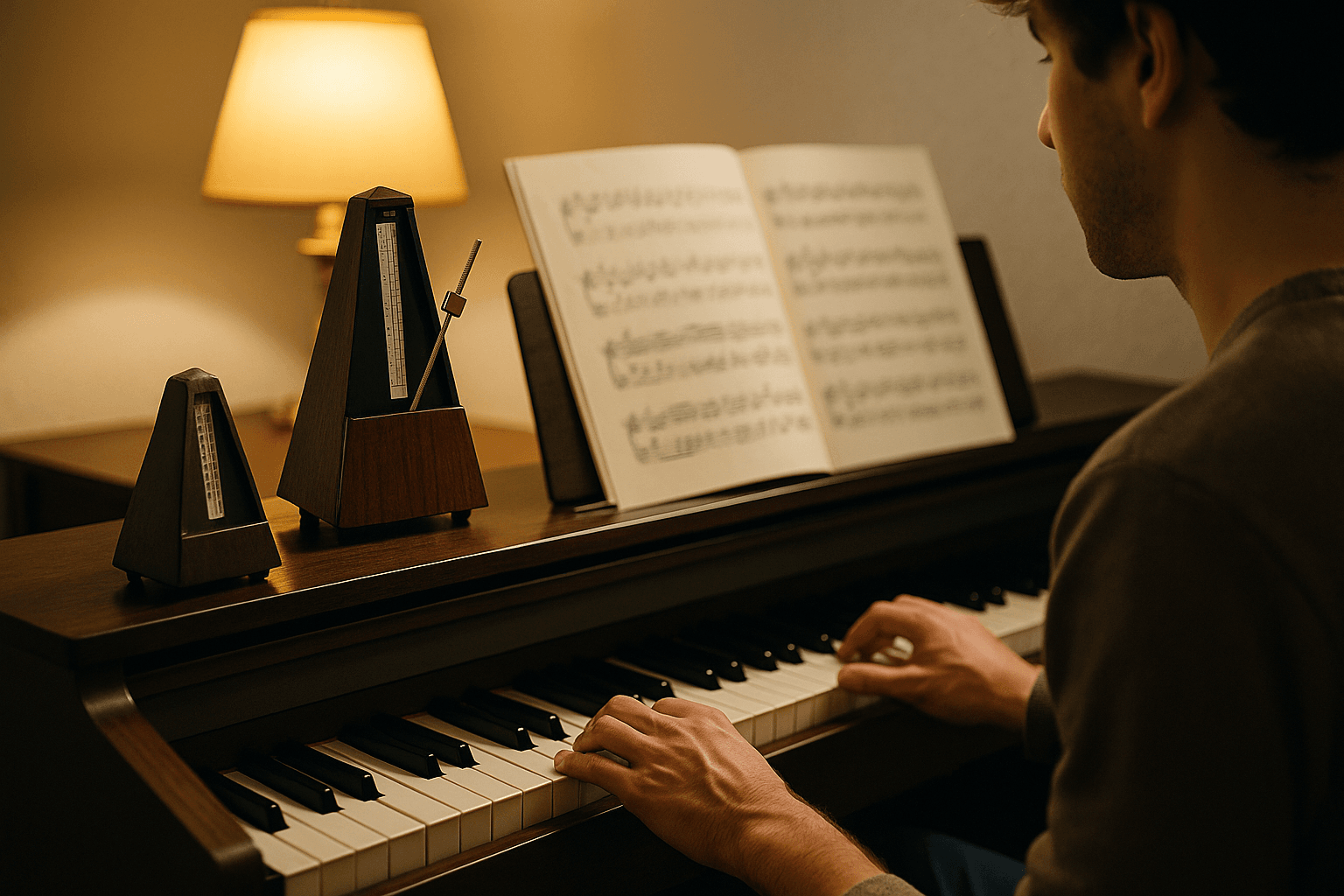 Every musician’s style evolves through consistent rhythm training. The metronome teaches patience, discipline, and awareness of tempo control. These traits slowly become part of a musician’s personality. Whether in metronome for classical music or contemporary styles, consistent metronome use shapes unique timing habits that define your sound. Legendary performers, from Beethoven’s metronome markings to modern drummers, have all relied on this simple device to refine their craft.
Every musician’s style evolves through consistent rhythm training. The metronome teaches patience, discipline, and awareness of tempo control. These traits slowly become part of a musician’s personality. Whether in metronome for classical music or contemporary styles, consistent metronome use shapes unique timing habits that define your sound. Legendary performers, from Beethoven’s metronome markings to modern drummers, have all relied on this simple device to refine their craft.
Think of your metronome as a friend that keeps you honest. It never complains, never tires, and always stays consistent. Many professional musicians describe it as a guide that sharpens focus and develops performance synchronization. From beginners to experts, every artist benefits from keeping this silent mentor close during practice sessions.
Using a metronome builds strong rhythmic awareness and enhances musical timing accuracy. It creates confidence in performance and ensures that every beat is steady and controlled. Whether you use a mechanical metronome, digital metronome, or metronome app, the habit of daily rhythm practice will shape your growth. As technology advances, tools like online metronome tool and digital music learning resources make timing practice easier than ever. Every musician, no matter the level, should embrace this simple yet powerful instrument for lasting progress.
Musicians use metronomes to develop rhythm and tempo control, maintain tempo consistency, and improve timing precision during practice.
The main types include mechanical metronomes, electronic metronomes, and smartphone metronomes. Online versions also exist for digital learning environments.
You should use a metronome whenever you’re learning new pieces, improving timing and coordination, or refining tempo accuracy for performance.
Adjust the beats per minute (BPM) according to your piece’s tempo markings. Start slow and gradually increase until you reach the original tempo.
Set your metronome to accent every fourth beat. This helps you maintain the time signature in music correctly.
In metronome for piano practice, begin with slow sections, ensuring both hands stay synchronized. Gradually increase the tempo while keeping clarity.
Metronome for guitar players helps maintain consistent strumming and picking. Start with 60–70 BPM and increase slowly as your timing improves.
Mechanical metronomes can last decades if maintained, while digital and app-based versions depend on battery life or software updates.
